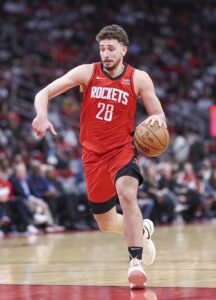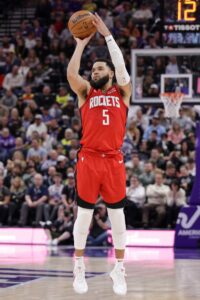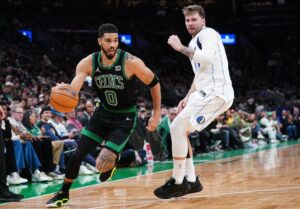After winning no more than 22 games for three consecutive seasons, the Rockets entered last summer armed with a ton of cap room and a determination to move out of their rebuilding phrase and toward legitimate contention. After hiring Ime Udoka as their new head coach, they focused on veteran free agents who could make an impact on both ends of the court, missing out on Brook Lopez but landing Fred VanVleet and Dillon Brooks.
 The Rockets’ offseason moves were a success. VanVleet, Brooks, and Udoka were culture-setters in Houston, imposing their personalities on a team that played with a hard-nosed edge. The young core took a major step forward, as Alperen Sengun enjoying a breakout year, Jalen Green finished the season strong, Jabari Smith made significant strides in his second season, and Amen Thompson and Cam Whitmore showed real promise as rookies.
The Rockets’ offseason moves were a success. VanVleet, Brooks, and Udoka were culture-setters in Houston, imposing their personalities on a team that played with a hard-nosed edge. The young core took a major step forward, as Alperen Sengun enjoying a breakout year, Jalen Green finished the season strong, Jabari Smith made significant strides in his second season, and Amen Thompson and Cam Whitmore showed real promise as rookies.
While the Rockets still fell short of the postseason, they finished with a 41-41 record in a competitive Western Conference, nearly doubling their win total after posting a 22-60 mark in 2022/23.
The roster will start to get more expensive once the players on rookie contracts graduate to their second deals, but the front office has done a nice job staggering its financial commitments (VanVleet’s guaranteed money expires in 2025 at the same time Green’s and Sengun’s next deals would begin) and has an excess of future first-round picks despite not controlling its own 2024 and 2026 first-rounders. Houston’s youngsters have room to keep improving, and the team has the cap and roster flexibility to continue pursuing upgrades.
This version of the Rockets doesn’t yet have the same high ceiling that the James Harden-led teams of the late-2010s did, but there’s reason for genuine optimism in Houston again after a rough couple years following the trade that sent Harden to Brooklyn.
The Rockets’ Offseason Plan
After carrying more than $60MM in cap room into the 2023 offseason, the Rockets don’t project to be under the cap this summer. They have nearly $122MM in guaranteed money on the books, plus a $10MM cap hold for their lottery pick, leaving no meaningful room below the projected cap of $141MM even if they purge the roster of non-guaranteed salary, team options, and cap holds for free agents.
Houston does have some interesting decisions to make though, starting with whether or not to retain Jeff Green ($8MM team option), Jock Landale ($8MM non-guaranteed salary), and Jae’Sean Tate ($7.6MM team option).
It’s hard to make a convincing case that any of Green, Landale, or Tate would match or exceed their current 2024/25 salaries if they were waived and then signed new contracts. But it won’t be all that surprising if the Rockets bring back at least two – and perhaps all three – of those players for one important reason: their mid-sized cap hits and lack of guaranteed money beyond ’24/25 would make them logical trade chips in a deal for an impact player.
With no cap room available, the Rockets aren’t in position to take on a significant salary outright, and they don’t have many obviously expendable guaranteed contracts on their books. Only six Houston players are earning more than $5.5MM next season: VanVleet, Brooks, Steven Adams, Green, Smith, and Thompson.
I can’t see VanVleet and Brooks going anywhere after the positive impact they had in their first year as Rockets; Houston will want to see what it has in Adams after acquiring an injured version of him at February’s trade deadline; and while perhaps one of those younger players could be included in a package for a star, none are earning more than $12.5MM, so their salary-matching potential is limited.
In other words, the combined $23.6MM that Green, Landale, and Tate would be owed in 2024/25 could come in handy as flotsam in a trade, even if none of those players are major contributors on the court. Guaranteeing all three contracts would increase the Rockets’ team salary to about $154MM for 13 players, giving the club plenty of breathing room below the projected luxury tax line of $171MM. The club would still have enough flexibility to go shopping for one more complementary role player using the non-taxpayer mid-level exception (it will be worth about $12.9MM).
The trade target most frequently connected to the Rockets has been Nets forward Mikal Bridges, who makes sense for a variety of reasons. For one, he’s the sort of two-way contributor Houston has prioritized under Udoka. Bridges’ scoring efficiency and perimeter defense took a step back this past season, but that’s likely because he was asked to be the No. 1 offensive option in Brooklyn. If he were a Rocket, he’d be leaned on more for his three-and-D prowess than his scoring, allowing him to take better shots on offense and preserve his energy for tough defensive assignments.
One crucial reason Bridges would be such a logical trade target is the fact that the Rockets control the Nets’ first-round draft picks for several years, starting with the No. 3 overall pick in 2024. Houston also owns Brooklyn’s unprotected 2026 first-rounder and has swap rights in 2025 and 2027.
Bridges’ $23.3MM cap hit would be easy to match with expiring contracts and perhaps a prospect or two, and the Rockets could offer the Nets control of their first-round picks back (along with other draft assets), putting Brooklyn in a far better position to retool. However, to date, the Nets have resisted the idea of trading Bridges, reportedly expressing a preference to build around him.
If the Rockets have no luck in their pursuit of Bridges, they could pivot to other targets with similar skill sets. Paul George and OG Anunoby would make a lot of sense on Houston’s roster, but both will be free agents and are unlikely to choose Houston over strong alternatives in Los Angeles, New York, and/or Philadelphia. Brandon Ingram is expected to be available via trade, though he’s not the kind of defensive stopper the Rockets would ideally want.
The most intriguing non-Bridges trade candidate for Houston’s purposes might be Jerami Grant. The Trail Blazers have shown little interest in moving him so far, but given how far away they are from contention, they’d be wise to listen to offers — and the Rockets could make a good one. Bruce Brown and Dorian Finney-Smith are among the lower-level trade candidates who could be fits in Houston.
The Rockets can afford to be patient if no good opportunities arise on the trade market this summer, circling back to consider their options at the 2025 trade deadline. By that time, they may get a better idea of what they have in Tari Eason, a 23-year-old wing whose career got off to a promising start before his sophomore season ended after just 22 games due to left leg surgery. It’s impossible to predict what sort of trajectory Eason’s career might follow coming off a major injury and based on such a small sample, but his three-and-D upside is real. In a best-case scenario, he develops into exactly the kind of player the Rockets are currently eyeing on the trade market.
Houston also has an opportunity to land a future impact player using the No. 3 overall pick, assuming it’s not included in a trade. As we’ve noted repeatedly, this year’s draft class is considered weak, but the Rockets don’t need to land a franchise player with that pick — turning it into another above-average rotation player would be a success. Kentucky’s Reed Sheppard would be an intriguing option for a Rockets team in need of shooting. Houston finished 23rd in the NBA last season with a 35.2% conversion rate on three-pointers, while Sheppard knocked down an incredible 52.1% in his freshman year.
Whether or not the Rockets add shooting in the draft or via trade, they’ll be in position to do so on the free agent market using the MLE. Caleb Martin, Derrick Jones, Naji Marshall, and Isaac Okoro are among the potential three-and-D free agent wings in the mid-level range to keep an eye on for Houston.
Finally, while the Rockets can wait a year on this front if they need to, it’s worth noting that Sengun and Green will both be eligible for rookie scale extensions this offseason. Neither situation is clear-cut. Sengun had an awesome third year, but Houston played some of its best basketball down the stretch without him, and the team hasn’t yet gotten a chance to see how effective he can be alongside a more traditional starting center like Adams.
As for Green, he was terrific during the season’s final few weeks, but was that enough for the Rockets to feel comfortable making a massive financial commitment to him? Before closing out the year by averaging 24.5 points and 4.0 assists per game on .454/.373/.808 shooting in his final 24 games, Green had put up 17.6 PPG and 3.4 APG on .406/.308/.802 shooting in his first 58 contests.
Unless they can get him to agree to a relatively team-friendly rate well below the max, the Rockets may want to see a little more from Green in terms of scoring efficiency and defense. Both he and Sengun would be restricted free agents in 2025 if they don’t sign extensions this offseason.
Salary Cap Situation
Guaranteed Salary
 Fred VanVleet ($42,846,615)
Fred VanVleet ($42,846,615)- Dillon Brooks ($22,255,493)
- Steven Adams ($12,600,000)
- Jalen Green ($12,483,048)
- Jabari Smith ($9,770,880)
- Amen Thompson ($9,249,960)
- Alperen Sengun ($5,424,654)
- Tari Eason ($3,695,160)
- Cam Whitmore ($3,379,080)
- Total: $121,704,890
Non-Guaranteed Salary
- Jock Landale ($8,000,000)
- Landale’s salary will become guaranteed if he remains under contract through June 29.
- Total: $8,000,000
Dead/Retained Salary
Player Options
Team Options
- Jeff Green ($8,000,000): Non-Bird rights
- Green’s salary would remain non-guaranteed until July 11 if his option is exercised.
- Jae’Sean Tate ($7,565,217): Bird rights
- Tate’s cap hit includes a $7,065,217 base salary and $500,000 in likely incentives.
- Total: $15,565,217
Restricted Free Agents
Two-Way Free Agents
Draft Picks
- No. 3 overall pick ($10,128,480 cap hold)
- No. 44 overall pick (no cap hold)
- Total (cap holds): $10,128,480
Extension-Eligible Players
- Steven Adams (veteran)
- Extension-eligible as of October 1.
- Jalen Green (rookie scale)
- Alperen Sengun (rookie scale)
- Jae’Sean Tate (veteran)
- Team option must be exercised.
Note: Unless otherwise indicated, these players are eligible for extensions beginning in July.
Unrestricted Free Agents
Cap Exceptions Available
Note: The Rockets project to operate over the cap and under the first tax apron.
- Non-taxpayer mid-level exception: $12,859,000
- Bi-annual exception: $4,681,000
- Trade exception: $4,510,000
 The Rockets’ offseason moves were a success. VanVleet, Brooks, and Udoka were culture-setters in Houston, imposing their personalities on a team that played with a hard-nosed edge. The young core took a major step forward, as
The Rockets’ offseason moves were a success. VanVleet, Brooks, and Udoka were culture-setters in Houston, imposing their personalities on a team that played with a hard-nosed edge. The young core took a major step forward, as 
 Only 21 teams in NBA history have won more games in a single regular season than the Celtics did this year, and 15 of those clubs won championships.
Only 21 teams in NBA history have won more games in a single regular season than the Celtics did this year, and 15 of those clubs won championships.